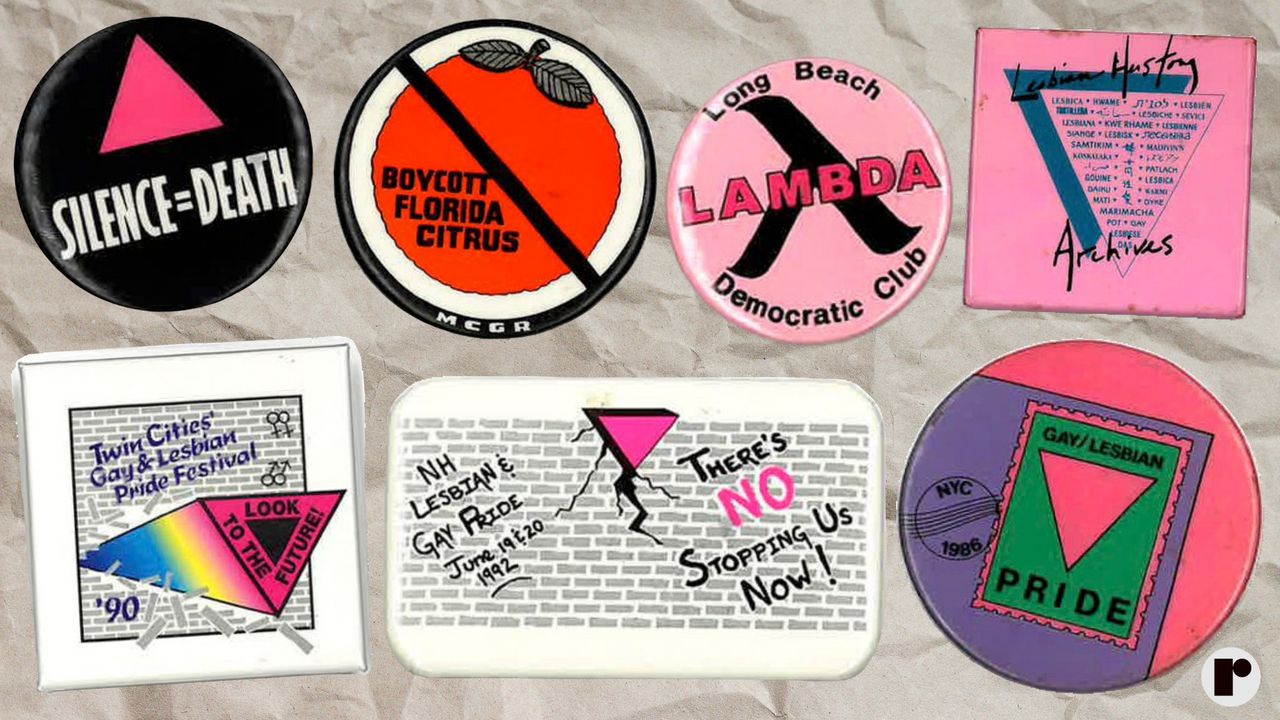From the Queer Archives: How buttons can teach us about LGBTQ history
In June streets are taken over by rainbows in celebration of Pride month. Rainbow flags, rainbow crosswalks, rainbow yard signs, and rainbow clothing on the people marching in pride parades. Although rainbow colors have become synonymous with LGBTQ pride, especially in the month of June, the queer and trans community has always had a greater array of symbols representing the community and signifying to other LGBTQ people a sense of familiarity and belonging. Digging through buttons found in the archives of an array of symbols that continue to hold meaning in the LGBTQ community emerged.
The Pink Triangle.
Reclaimed from the markings used in Nazi persecution of homosexuals in concentration camps from 1933 to 1945, the upside-down pink triangle first appeared in the gay and lesbian community throughout the Gay Liberation Movement of the 1970s. During the AIDS Crisis the pink triangle was flipped right sight up and reclaimed by ACT UP (AIDS Coalition to Unleash Power), appearing above the text SILENCE = DEATH in 1987, marking the moment when the pink triangle became iconic as a symbol of protest and visibility.
The Lambda Symbol.
First adopted by the New York Gay Activists Alliance in 1970, the lowercase lambda became a symbol alongside the pink triangle during Gay Liberation to represent the gay and lesbian community. Although many attribute the lambda symbol to its Greek origins, the lambda in the gay community often has a more militant connotation because of its scientific meaning. In chemistry the lambda stands for catalyst while in physics it represents kinetic energy. Both scientific meanings represent movement and action, a force, the lambda becoming a protest call for members of lesbian and gay organizations using the symbol throughout the 1970s.
Anita and the Oranges.
The pieing of Anita Bryant is celebrated on March 14th every year in queer and trans communities by circulating pictures of her smothered in pie. Famously pied by Thom Higgins in Des Moines, Iowa on October 14th, 1977, Bryant gave our community another symbol, the orange. In this case the orange did not become a symbol of the LGBTQ community, but boycotting the orange and orange juice did. This is because Bryant was famously the face of Florida orange juice and then began a nation-wide anti-gay “Save the Children” campaign. This crusade of Bryant’s combatted city ordinances protecting people from discrimination on the basis of sexual orientation. Gay and lesbian boycotts of oranges and orange juice and Bryant’s public hate led to the Florida Citrus Commission to terminate her contract.
A Brick or Brick Wall.
It is hard to talk about Pride without talking about Stonewall and the first brick. Although the raid on the Stonewall Inn on June 28th, 1969, that led to days of riots was neither the first raid on a gay bar nor the first protest of policing in the gay community, it has served as the marker of Pride. There is deep lore and even longer engrained arguments about “who threw the first brick” and whether a brick was even thrown at all to begin the riots, a brick wall has become a symbol of Pride.
Aiden M. Bettine is a trans archivist and historian. He is the Curator of the Tretter Collection in GLBT Studies at the University of Minnesota Libraries,the co-founder of Late Night Copies Press, a Minneapolis-based micropress that prints on photocopiers, and founder of the LGBTQ Iowa Archives & Library, a volunteer-led community archives & lending library in Iowa City. He specializes in researching and writing about queer and trans history throughout the Midwest.
